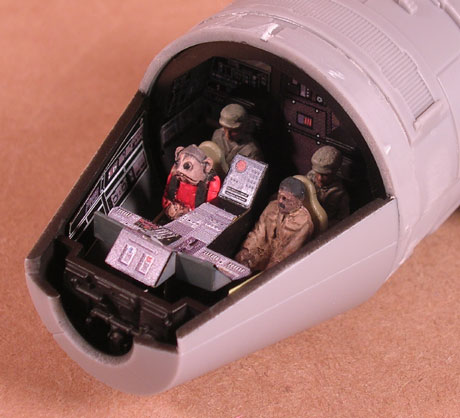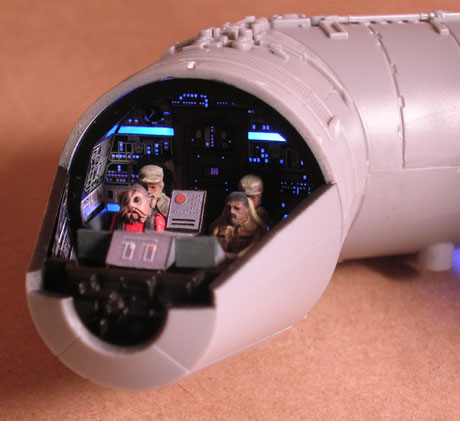Your cart is currently empty!
In Progress » Millenium Falcon [1/72 Fine Molds Kit] » Wired and Painted
Now that the Tantive IV is done and I’m feeling refreshed and inspired to model again, I’ve come back to the Millenium Falcon build. “Come back” you say? Yeah… I started this in August and got it almost ready for paint, then something happened and I put it aside for a while. I had posted pics of the beginnings of Facebook, but not in the site. No worries as I’m reposting those pics here as well. This build will eventually go into the large Death Star 2 diorama. Here it is compared to the A-Wing, also to be in the diorama.

My client and I decided that this beastie needed to be fully lit. Wiring was the usual pain in the ass having burned myself several times and melting a few LEDs in the process causing some rework. I’m not used to soldering but I wanted everything to be very robust. The usual wire wrap I use is too brittle to risk inside of this.

Using the Acreations photoetch update set I was able to easily do the cockpit lighting. The set is awesome and has all the holes to backlight the consoles ready to go. Just paint and add the fantastic decals and the cockpit is about ready.

The figures with the exception of Nien Nunb the copilot were modified from the kit figures. Basically I just added rebel hats to Luke and Obiwan made from Aves and modded Han to make Lando. Nien Nunb is from a Studio Starforge resin figure set.

Lincoln is huge.

And now onto the good part… the kit construction was finished yesterday so what you see below is todays progress. I decided to do a short step-by-step on the painting process since there was a lot if interest in how I did the Tantive IV paint.
I started off by priming the kit. I didn’t have any typical gray primer, but I had dark gray and white Duplicolor primer. So I first primed it in the dark gray primer, then applied a second coat of the white. This had a slight shading benefit and came out the base primer gray I wanted. Windows were masked with Parafilm “M”.
Next I preshaded the panel lines and recesses using Tamiya German Gray. No need to be precise as the effect will be pretty subtle after the top-coat. If not… you’re not doing it right. If you’re having trouble, your top-coat may be too thin or your pre-shade may be too dark. Experiment with different color preshades. For a tan vehicle, try a brown pre-shade, etc…
Next I applied the top-coat. This was a mixture of Tamiya Flat White (1 jar) + Tamiya Gloss White (1/3 Jar) + Tamiya Flat Earth and Neutral Gray. Apply it uniformly on the tops and bottoms and spray at an angle over detail areas to retail some of the pre-shade in recesses.
Once the top-coat cured a bit I masked and painted the dulled red markings. I would apply tape, then sponge on some 502 Abteilung Liquid Mask for the chips. Once sprayed and cured a bit rub the mask off to reveal the chips. After that I sponged on some light gray chips. This will show up as chips and texture in the end. Mostly be careful not to over-do it. I concentrated on areas in the reference that were chipped as well as masses of raised detail parts. You may notice I did not mask the dark gray or yellow panels. This is because I plan to hand-paint these with oils during the later modulation phase. I did this with some of the darker panels on the Tantive IV with great results.
When the chipping is done immediately apply your first filter. I used a 502 Abteilung German Ochre oil paint thinned with odorless turpenoid. This is thinner than a wash, but not applied like a wash. Just dampen your brush and paint it onto the kit. If it’s flowing into panel lines and pooling you’re brush is too wet with filter. Depending on your thinness or desired color you may need a few layers of filter. You should wait 4-12 hours inbetween. The filter soaks into the flat paint quite nicely so try to do it before any clearcoats.
The filter will slightly modify your paint colors. You may be asking: “Why filter it at all? Why not paint it the right color from the start”. Well, sometimes it’s hard to get the right paint color as they tend to look different after sprayed from an airbrush and dry. The filter is like using Photoshop on your model to tweak the color. It also has the benefit of being uneven enough to act as the first signs of weathering and to tie unrelated colors together so that they look like they belong on the same model/saw the same conditions.
And finally for this update, some pics of the lighting. I still need to install the clear engine parts casts and the covering “grill”.

















![Maude [Cyborg Action-Doll] (Files Only)](https://fichtenfoo.net/blog/wp-content/uploads/2023/01/Maude-Promos-300x300.jpg)


